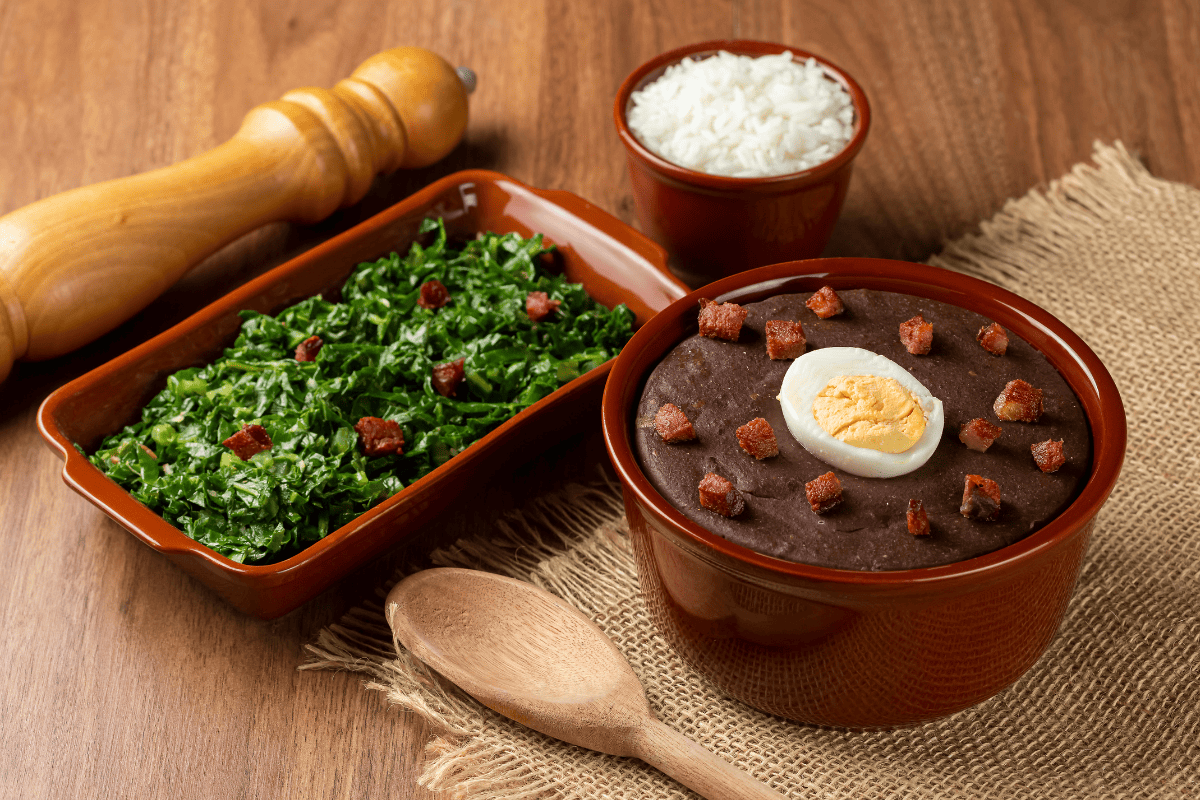
Collard greens, known as “couve” in Portuguese, play a significant role in Brazilian cuisine. They are a staple side dish often served alongside traditional Brazilian dishes like Feijoada (a black bean stew with pork) and grilled meats. Collard greens are not only delicious but also nutritious, providing essential vitamins and minerals that complement the richness of many Brazilian dishes. Today’s recipe is called couve mineira, a wildly popular version of Brazilian collards with bacon.
Are Brazilian Collards Good For You?
Brazilian collards often incorporate light frying and bacon, but this does not detract from the inherent nutritional value of the collards themselves. A part of the cruciferous family (along with broccoli, cabbage, Brussels sprouts, etc.), collard greens are low in calories and high in dietary fiber. 3.5 oz of boiled collards also contains nearly four times your daily value of Vitamin K, a vitamin essential for blood coagulation and binding calcium to your bones and tissues.
Like other leafy greens, collards also provide a decent punch of Vitamin C and Vitamin A, along with important minerals like iron and manganese.
If you want a lighter version of this recipe, simply omit the bacon and use just the extra virgin olive oil for frying. It’s equally delicious!
Brazilian Collards vs Southern Collards
In the US, collards are a staple of Southern cooking. More specifically, they hold cultural importance in Black Southern cuisine. Collard greens were often grown in home gardens by slaves to supplement meager rations. They were prized for their hardiness both during the winter and in the sweltering summer heat.
Today, collards continue to be an important side dish throughout the South and hold a special place in the category of Soul Food. Southern collard greens are usually rough-chopped or torn into bite-sized pieces, then slow-simmered in broth with a smoky piece of protein, such as a turkey leg.
While Brazil has an abundance of African influence in its cuisine, it is likely that collards made their way to the country via Portuguese colonists. Collard greens are a favorite ingredient in many Portuguese dishes, such as caldo verde, a hearty green soup.
Unlike Southern collards, Brazilian collards are not usually slow-cooked. Rather, they are typically sliced into thin strips. The smaller size means they cook more quickly, lending themselves to sauteeing versus boiling or simmering.
Substitutes for Brazilian Collard Greens
While most Brazilians will argue staunchly against using anything but collard greens for this recipe, you can substitute kale or even shaved brussels sprouts if you prefer. Swiss chard would also be acceptable, since it maintains its “bite” after a light sautee. You won’t want to use broccoli or cauliflower, since they won’t cook through with this method.
Recipe for Brazilian Collard Greens (Couve Mineira)
Ingredients:
1 bunch of fresh collard greens
6 slices of bacon
1 medium onion, finely chopped
2 cloves garlic, minced
Salt and black pepper to taste
Red pepper flakes (optional, for a spicy kick)
Extra virgin olive oil
Instructions:
- Wash the collard greens thoroughly under cold running water to remove any dirt or sand. Drain and pat them dry with a kitchen towel or paper towels.
- Remove the tough stems from the collard greens by folding each leaf in half lengthwise and cutting along the stem. Discard the stems or save them for making vegetable stock.
- Stack the collard green leaves on top of each other, roll them into a tight cylinder, and slice them into thin strips (about 1/4-inch wide). This technique is known as chiffonade.
- In a large skillet or frying pan, cook the bacon over medium heat until it becomes crispy. Remove the bacon slices from the pan and place them on paper towels to drain excess fat. Once cool, crumble the bacon into small pieces and set it aside.
- Drain all but a tablespoon of the bacon fat from the pan. If needed, add a drizzle of extra virgin olive oil. Add the chopped onion and minced garlic. Sauté them until they become translucent and fragrant.
- Add the sliced collard greens to the skillet, tossing them with the onions and garlic. Cook for 5-7 minutes, stirring occasionally, until the collard greens are tender and slightly wilted. If needed, you can cover the skillet for a few minutes to help them cook faster.
- Season the collard greens with salt, black pepper, and red pepper flakes (if desired). Be cautious with the salt, as the bacon already adds saltiness.
- Return the crumbled bacon pieces to the skillet and mix them with the collard greens.
- Taste and adjust the seasoning as necessary. If you prefer a slightly crispy texture, you can cook the collard greens for a few additional minutes.
- Once the collard greens are tender and well-seasoned, remove the skillet from heat.
Serve your Brazilian collards as a side dish to complement your favorite meals. Enjoy!
What To Eat With Collards
Brazilian collards go well with a wide variety of dishes. They are a must with feijoada, but are just as tasty with a medium rare skirt steak or picanha roast. If you can’t make up your mind, why not try a hand-curated box of premium cuts of beef, lamb, and pork delivered right to your door? Texas de Brazil’s online butcher shop features complete boxes and a la carte options to suit every taste. Get one for you and a friend for a truly elevated barbecue experience!
